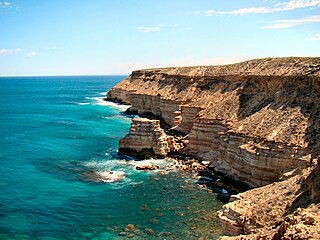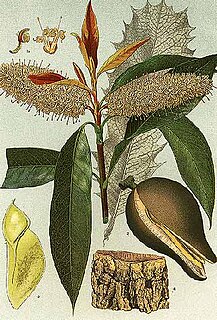
Kalbarri National Park is located 485 km (301 mi) north of Perth, in the Mid West region of Western Australia.

Chamaenerion angustifolium is a perennial herbaceous flowering plant in the willowherb family Onagraceae. It is known in North America as fireweed, in some parts of Canada as great willowherb, in Britain and Ireland as rosebay willowherb. In the United Kingdom it is also known as bombweed, as a result of its rapid appearance on city bomb sites during the Blitz of World War II; the plant is also traditionally known as Saint Anthony's Laurel. It is also known by the synonyms Chamerion angustifolium and Epilobium angustifolium. It is native throughout the temperate Northern Hemisphere, including large parts of the boreal forests.

Eriophorum angustifolium, commonly known as common cottongrass or common cottonsedge, is a species of flowering plant in the sedge family, Cyperaceae. Native to North America, North Asia, and Northern Europe, it grows on peat or acidic soils, in open wetland, heath or moorland. It begins to flower in April or May and, after fertilisation in early summer, the small, unremarkable brown and green flowers develop distinctive white bristle-like seed-heads that resemble tufts of cotton; combined with its ecological suitability to bog, these characteristics give rise to the plant's alternative name, bog cotton.

Xylomelum is a genus of six species of flowering plants, often commonly known as woody pears, in the family Proteaceae and are endemic to Australia. Plants in this genus are tall shrubs or small trees with leaves arranged in opposite pairs, relatively small flowers arranged in spike-like groups, and the fruit a woody, more or less pear-shaped follicle.

Dysoxylum is a flowering plant genus of trees and shrubs from the mahogany family, Meliaceae.

Banksia sceptrum, commonly known as the sceptre banksia, is a plant that grows in Western Australia near the central west coast from Geraldton north through Kalbarri to Hamelin Pool. It extends inland almost to Mullewa. First collected and grown by early settler James Drummond in Western Australia, it was described by Swiss botanist Carl Meissner in 1855.

Hypocalymma is a genus of evergreen shrubs in the myrtle family Myrtaceae described as a genus in 1840. The entire genus is endemic to southern Western Australia.

Glischrocaryon is a genus of flowering plants in the family Haloragaceae, endemic to Australia. Species occur in New South Wales, Victoria, South Australia and Western Australia include:
Verticordia aurea, commonly known as buttercups is a flowering plant in the myrtle family, Myrtaceae and is endemic to the south-west of Western Australia. It is a slender, sometimes bushy shrub with a single stem at the base, cylindrical leaves and heads of scented, golden-yellow flowers in spring.

Hypocalymma angustifolium, the white myrtle, is a species of shrub in the myrtle family Myrtaceae, endemic to the south west region of Western Australia. The Noongar peoples know the plant as koodgeed or kudjidi.

Trymalium is a genus of shrubs or trees in the family Rhamnaceae. The species are endemic to Western Australia but for one, Trymalium wayi, that occurs in South Australia. They are found in forest and semiarid woodland and shrubland of the kwongan in southwest Australia, and the outlying species of South Australia is found on rocky slopes, notably at the Mount Lofty and Flinders Ranges.

Xylomelum pyriforme, commonly known as the woody pear, is a species of plant in the family Proteaceae native to eastern Australia. It grows as a large shrub or small tree to five metres high.

Clerodendrum floribundum, known as the lolly bush or smooth clerodendrum, is a shrub or tree found in Australia and New Guinea. The habitat is in or at the margins of coastal rainforests, up to 300 metres above sea level. In Western Australia it grows in drier areas; such as rocky sites, gorges, cliffs, floodplains and creek beds.

Xylomelum occidentale, commonly known as the western woody pear, is a tree species in the family Proteaceae. It is endemic to Western Australia.

Pittosporum angustifolium is a shrub or small tree growing throughout inland Australia. Common names include weeping pittosporum, butterbush, cattle bush, native apricot, apricot tree, gumbi gumbi, cumby cumby, meemeei, poison berry bush, and berrigan.
Xylomelum benthamii is a plant in the woody pear genus of the family Proteaceae. It was formerly considered a variety of Xylomelum pyriforme. It is native to south-eastern Queensland, Australia, and was described from material collected on 25 June 1829 on the Brisbane River some 140 km north-west of what is now Brisbane, the state capital. It was mistakenly linked with the name Xylomelum salicinum (Meisn.) Benth., and was given the replacement name X. benthamii in 2007 by A.E. Orchard, with the specific epithet honouring botanist George Bentham.

Xylomelum cunninghamianum is a species of flowering plant in the family Proteaceae and is endemic to eastern Australia. It is a shrub or small tree with narrow elliptic to lance-shaped leaves with toothed edges when young, groups of flowers covered with brownish hairs and oval fruit densely covered with velvety rust-coloured to grey hair.
Xylomelum scottianum is a shrub or small tree in the woody pear genus of the family Proteaceae that is commonly known as the northern woody pear. It grows to 10 m in height. endemic to Australia, it is widespread in dry areas of Cape York Peninsula, Queensland, and on Thursday Island in Torres Strait. It is common on sandy soils in open forests, at altitudes of up to 440 m above sea level. It flowers from October to May. The brown seeds are 68–75 mm long. It was used medicinally by the Aboriginal people, as an infusion of the bark and leaves, drunk to relieve internal pain.

Calothamnus brevifolius is a plant in the myrtle family, Myrtaceae and is endemic to the south-west of Western Australia. It is a small, highly branched shrub with almost cylindrical, pointed leaves and red flowers in summer. In 2014 Craven, Edwards and Cowley proposed that the species be renamed Melaleuca hawkeswoodii.
Don Foreman was an Australian botanist who worked on the Monimiaceae and Proteaceae of Australia. He also helped with the editing of selected Flora of Victoria and Flora of Australia Volumes.
















